Hieroglyphics input methods
In view of the growing popularity of the Chinese language in recent years, I decided to share my experience and small developments in the principles and methods of introducing these most mysterious hieroglyphs. First, a little theory of what it is and what it is.
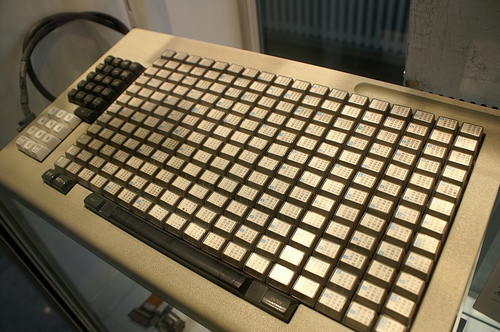
What is a Chinese letter? Words are formed from one or several hieroglyphs, in turn, the hieroglyph can be simple or composed of a key (radical) and graphic elements. Example: respectful greeting 您好 (Nín hǎo), the literal translation of which is "You are good." The first compound hieroglyph consists of 2 - 你
(Nín hǎo), the literal translation of which is "You are good." The first compound hieroglyph consists of 2 - 你  (Nǐ) - “You” and 心
(Nǐ) - “You” and 心  (Xīn) "heart". 你
(Xīn) "heart". 你  - also consists of 2 parts, key 亻
- also consists of 2 parts, key 亻  (short for 人
(short for 人  (Rén (man) and graphemes 尔
(Rén (man) and graphemes 尔  ((ěr) - in the modern language in an independent form is not used). In parentheses, I indicated the pronunciation of the hieroglyph, pinyin (pīnyīn), dashes over vowels - these are tones, in the northern dialect of China “Putonghua” there are 4 + neutral. Mandarin Chinese (also called mandarin), spoken in Beijing and the northeast, and which they are trying to spread as a standard of oral speech throughout the PRC. Many dialects, and if you can learn Beijing, Shanghai, you still do not understand. But do not be particularly scared - the written language is the same everywhere, so in QQ, on the forums and reading those. you will not feel the documentation of special discomfort.
((ěr) - in the modern language in an independent form is not used). In parentheses, I indicated the pronunciation of the hieroglyph, pinyin (pīnyīn), dashes over vowels - these are tones, in the northern dialect of China “Putonghua” there are 4 + neutral. Mandarin Chinese (also called mandarin), spoken in Beijing and the northeast, and which they are trying to spread as a standard of oral speech throughout the PRC. Many dialects, and if you can learn Beijing, Shanghai, you still do not understand. But do not be particularly scared - the written language is the same everywhere, so in QQ, on the forums and reading those. you will not feel the documentation of special discomfort.
That is, as everyone already guessed, the pronunciation of the hieroglyph with his writing is not much connected. It does not work by opening an unfamiliar text just to take it and voice it, without even understanding the meaning. So, if a crazy thought wanders into our smart heads to learn Chinese, I warn you right away that you will have to TEACH (read-cram) hieroglyphs and learn with pronunciation and tones.
So, we started to teach, created a new folder on the computer for our materials and try to call it. In Russian or English? Not professional! Open Google Translate and translate "Chinese" and get a beautiful "中国 的" . Congratulations, you have mastered the 1st input method. But I hurry to upset you, or anything like that. Chinese language - 汉语
. Congratulations, you have mastered the 1st input method. But I hurry to upset you, or anything like that. Chinese language - 汉语  (Hànyǔ). And now once again open the Translate, select the translation from Chinese -> Russian and enter “hanyu” on the English layout, without forgetting to tick the “Allow phonetic typing”, a window pops up, where you can select the desired option using the navigation keys.
(Hànyǔ). And now once again open the Translate, select the translation from Chinese -> Russian and enter “hanyu” on the English layout, without forgetting to tick the “Allow phonetic typing”, a window pops up, where you can select the desired option using the navigation keys.
')
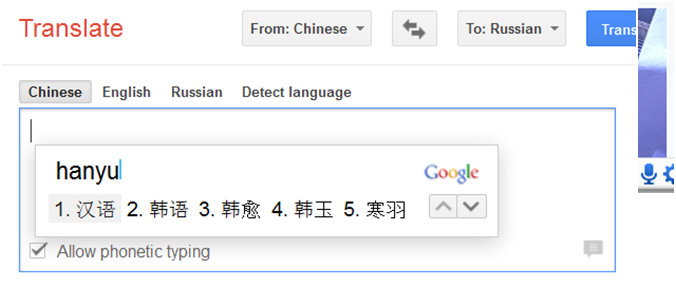
Yes, entering hieroglyphs with the help of phonetic writing that we just applied is called pinyin. This is the most common input method in China. Pretty quick and easy. It is enough to know the pronunciation of the word and remember its mark.
A dozen programs are written on Windows that will help us communicate with our brothers in their native language with the help of pinyin. I preferred 2m of them: Google Pinyin, Sogou pinyin. For the average person, the difference is not significant, the interface of both in Chinese. Sogou podbeshivaet frequent advertising and a bunch of unnecessary services included. Google has no such flaws. Both add a new layout, switching to which when you enter pops up a window like Google Translater.
For example, try to write 我 喜爱 的 哈伯尔阿哈 伯尔 (Wǒ xǐ'ài de hā bó ěrā hā bó ěr). Switch to the Chinese layout and feel free to enter woxiaide (my favorite). While we entered, the program selected a suitable version of the phrase that makes sense. It is worth noting that hieroglyphs with the same pronunciation are darkness, and it is better to introduce them in portions depending on the degree of difficulty of the phrase. Press the space bar and vuola - on the screen treasured 我 喜爱 的
(Wǒ xǐ'ài de hā bó ěrā hā bó ěr). Switch to the Chinese layout and feel free to enter woxiaide (my favorite). While we entered, the program selected a suitable version of the phrase that makes sense. It is worth noting that hieroglyphs with the same pronunciation are darkness, and it is better to introduce them in portions depending on the degree of difficulty of the phrase. Press the space bar and vuola - on the screen treasured 我 喜爱 的  .
.

Further more difficult. Proper names just can not enter. There is no letter. Therefore, the name of the city of Volgograd will look like and read Fú'ěrjiā gé lè. That is not only that they do not have sounds “in”, “p”, so also there is no possibility to write a combination of several sounds, if there is no such hieroglyph with such a sound. That is why the name of Misha will consist of 2 hieroglyphs 米沙
and read Fú'ěrjiā gé lè. That is not only that they do not have sounds “in”, “p”, so also there is no possibility to write a combination of several sounds, if there is no such hieroglyph with such a sound. That is why the name of Misha will consist of 2 hieroglyphs 米沙  (Mǐ Shā) - literally translated as “rice” and “sand”. Panic? Nothing is clear? I assure you, the Chinese too. At my request to check whether I wrote the word 哈伯尔阿哈 伯尔 correctly
(Mǐ Shā) - literally translated as “rice” and “sand”. Panic? Nothing is clear? I assure you, the Chinese too. At my request to check whether I wrote the word 哈伯尔阿哈 伯尔 correctly  (Habrahabr) Chinese girlfriend fell into a stupor. That this proper name is clear only from the context. So we are left only reluctantly to the cherished recognition of our project in love to introduce the next batch of pinyin "habo"
(Habrahabr) Chinese girlfriend fell into a stupor. That this proper name is clear only from the context. So we are left only reluctantly to the cherished recognition of our project in love to introduce the next batch of pinyin "habo"

and from the drop-down list select with the keys up - down “哈伯” space bar Next, on the thumb "er" - 尔
space bar Next, on the thumb "er" - 尔  , space, “a” - 阿
, space, “a” - 阿  , space, again “habo” - note that the required hieroglyphs are already in the first place, you can immediately press the space and “er” - 尔
, space, again “habo” - note that the required hieroglyphs are already in the first place, you can immediately press the space and “er” - 尔  . Everything, we check. 喜爱 的 哈伯尔阿哈 伯尔
. Everything, we check. 喜爱 的 哈伯尔阿哈 伯尔  (Wǒ xǐ'ài de hā bó ěrā hā bó ěr).
(Wǒ xǐ'ài de hā bó ěrā hā bó ěr).
What are the advantages of this method - it is not necessary to draw the hieroglyph itself, which takes much more time. No need to comply with the tone. We need to remember what the hieroglyph looks like and how it sounds. By the way, there is a very big difference between: knowing what a hieroglyph looks like and knowing how to write it. And so we will start learning to write them.
Here is a little easier. Imagine. Go, it means we are on the street, and on the fence, instead of the usual records, something like 出口 . And how should we deal with this? Pinyin we do not know these hieroglyphs, it means that the previous method is not our assistant. We open a wonderful site and next to the “Search” button we see a pencil, click, a whole field for the arts opens up, that’s where we need to redraw our hieroglyphs one by one.
. And how should we deal with this? Pinyin we do not know these hieroglyphs, it means that the previous method is not our assistant. We open a wonderful site and next to the “Search” button we see a pencil, click, a whole field for the arts opens up, that’s where we need to redraw our hieroglyphs one by one.
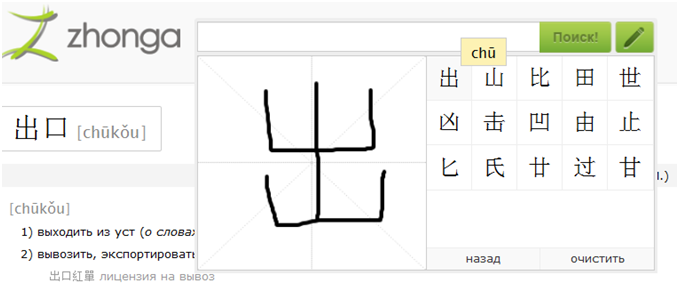
Here is a recognizer. Here you can see both the pronunciation and the translation. So next time, if we get lost in one of Beijing’s shopping centers, we can safely ask a question 出口 在 哪儿? Well, or at least look for a sign with such Krakabab.
Well, or at least look for a sign with such Krakabab.
The advantages of this method are the search for unfamiliar hieroglyphs. You can even adapt yourself and write with tolerable speed. Especially the method is practical on modern mobile devices with touchscreens, and implemented very conveniently.
There is a subspecies of the handwriting input method, or
If the ability to draw is not, or not, you can refer to this method. Its essence is that all the hieroglyphs are written using simple flourishes and lines. Each such line has its own name, for example, horizontal “heng”, vertical “shu”, vertical down and then horizontal to the right as it is easy to guess “shu heng”. Any oblique “pie” and “na”, points “dian”, ... here's a table for intimidation.
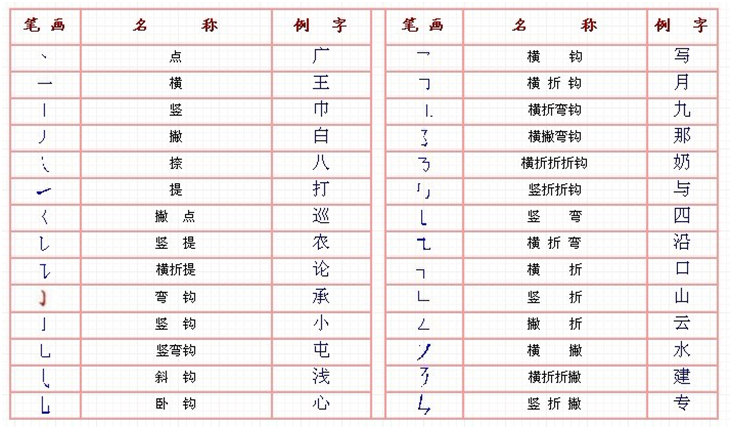
And, accordingly, there is a rule in which sequence these components of a hieroglyph should be written (if very exaggerated, then from top to bottom, from left to right). Knowing this rule, as well as the correspondence between the squiggles and letters (in different programs may differ, on my smartphone all the more beautiful) you can just enter it as well.
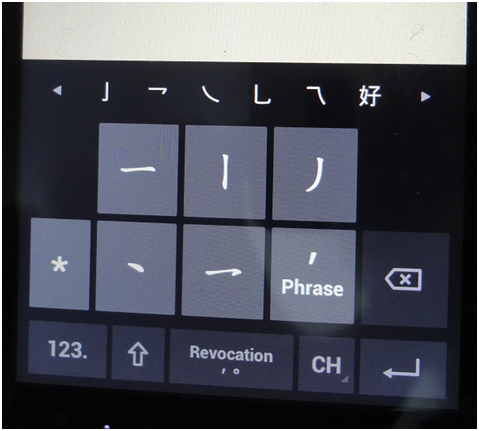
Pros - it is not necessary to be a happy owner of a touchscreen device, it is possible for each element to assign its own key. No need to draw, do not necessarily enter all the elements. Usually after 3-4 you get the desired hieroglyph.
The method is complex, not all Chinese are able to use it. But not all Chinese can even read and write. So if you want to conquer the hearts of millions and have a speed of about 150 characters per minute - you are here. For the beginning, you will have to learn the keys (radicals), there are not many of them, about 250. As we learn, we can lay out the hieroglyph into components (graphemes). Example: 车, 人, 一, 月, 刂.
Now you have to learn the location of these components on the keyboard. Here, too, everything is simple: 5 zones marked with different colors, serial numbers of zones and numbers corresponding to the number of features in the grapheme.
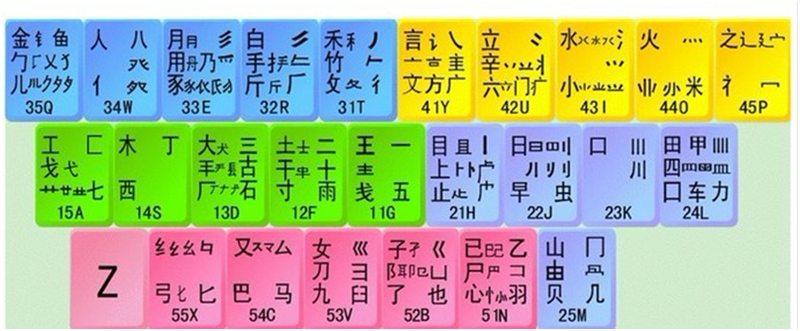
So, to introduce our hieroglyph , we have to find on the keyboard 4 keys corresponding to the graphemes: "车" - L, "人" - W, "一" - G, "刂" - J.
, we have to find on the keyboard 4 keys corresponding to the graphemes: "车" - L, "人" - W, "一" - G, "刂" - J.  (if the grapheme is more than 4x, the first 3 and the last are used).
(if the grapheme is more than 4x, the first 3 and the last are used).
It would seem that everything is simple, but there are many hieroglyphs consisting of 2 or 3 graphemes, the key combinations of which very often coincide. Here we will also have to learn 4 groups into which all the hieroglyphs (basic, hieroglyphs with unconnected graphemes, connected and intersecting), and the sequence number of the last hieroglyphic character, which make up the code for identifying the desired hieroglyph, are divided.
There are some more hybrid input methods that are not so common; speech recognition. But for productive learning without the extra cost of learning unnecessary things, my choice fell on pinyin. It's not just that I'm very lazy. We were taught from childhood to write letters corresponding to the sounds of speech, and pinyin in this regard is very similar to traditional phonetic writing.
If it seemed to someone that this is not rational, believe me, you are not the first to come to this thought. The mentality is different. Their path is thorny and indirectly, but whatever they do, they do it with great persistence and dedication. What you want.

Introduction
What is a Chinese letter? Words are formed from one or several hieroglyphs, in turn, the hieroglyph can be simple or composed of a key (radical) and graphic elements. Example: respectful greeting 您好
 (Nín hǎo), the literal translation of which is "You are good." The first compound hieroglyph consists of 2 - 你
(Nín hǎo), the literal translation of which is "You are good." The first compound hieroglyph consists of 2 - 你  (Nǐ) - “You” and 心
(Nǐ) - “You” and 心  (Xīn) "heart". 你
(Xīn) "heart". 你  - also consists of 2 parts, key 亻
- also consists of 2 parts, key 亻  (short for 人
(short for 人  (Rén (man) and graphemes 尔
(Rén (man) and graphemes 尔  ((ěr) - in the modern language in an independent form is not used). In parentheses, I indicated the pronunciation of the hieroglyph, pinyin (pīnyīn), dashes over vowels - these are tones, in the northern dialect of China “Putonghua” there are 4 + neutral. Mandarin Chinese (also called mandarin), spoken in Beijing and the northeast, and which they are trying to spread as a standard of oral speech throughout the PRC. Many dialects, and if you can learn Beijing, Shanghai, you still do not understand. But do not be particularly scared - the written language is the same everywhere, so in QQ, on the forums and reading those. you will not feel the documentation of special discomfort.
((ěr) - in the modern language in an independent form is not used). In parentheses, I indicated the pronunciation of the hieroglyph, pinyin (pīnyīn), dashes over vowels - these are tones, in the northern dialect of China “Putonghua” there are 4 + neutral. Mandarin Chinese (also called mandarin), spoken in Beijing and the northeast, and which they are trying to spread as a standard of oral speech throughout the PRC. Many dialects, and if you can learn Beijing, Shanghai, you still do not understand. But do not be particularly scared - the written language is the same everywhere, so in QQ, on the forums and reading those. you will not feel the documentation of special discomfort.That is, as everyone already guessed, the pronunciation of the hieroglyph with his writing is not much connected. It does not work by opening an unfamiliar text just to take it and voice it, without even understanding the meaning. So, if a crazy thought wanders into our smart heads to learn Chinese, I warn you right away that you will have to TEACH (read-cram) hieroglyphs and learn with pronunciation and tones.
So, we started to teach, created a new folder on the computer for our materials and try to call it. In Russian or English? Not professional! Open Google Translate and translate "Chinese" and get a beautiful "中国 的"
 . Congratulations, you have mastered the 1st input method. But I hurry to upset you, or anything like that. Chinese language - 汉语
. Congratulations, you have mastered the 1st input method. But I hurry to upset you, or anything like that. Chinese language - 汉语  (Hànyǔ). And now once again open the Translate, select the translation from Chinese -> Russian and enter “hanyu” on the English layout, without forgetting to tick the “Allow phonetic typing”, a window pops up, where you can select the desired option using the navigation keys.
(Hànyǔ). And now once again open the Translate, select the translation from Chinese -> Russian and enter “hanyu” on the English layout, without forgetting to tick the “Allow phonetic typing”, a window pops up, where you can select the desired option using the navigation keys.')

Pinyin
Yes, entering hieroglyphs with the help of phonetic writing that we just applied is called pinyin. This is the most common input method in China. Pretty quick and easy. It is enough to know the pronunciation of the word and remember its mark.
A dozen programs are written on Windows that will help us communicate with our brothers in their native language with the help of pinyin. I preferred 2m of them: Google Pinyin, Sogou pinyin. For the average person, the difference is not significant, the interface of both in Chinese. Sogou podbeshivaet frequent advertising and a bunch of unnecessary services included. Google has no such flaws. Both add a new layout, switching to which when you enter pops up a window like Google Translater.
For example, try to write 我 喜爱 的 哈伯尔阿哈 伯尔
 (Wǒ xǐ'ài de hā bó ěrā hā bó ěr). Switch to the Chinese layout and feel free to enter woxiaide (my favorite). While we entered, the program selected a suitable version of the phrase that makes sense. It is worth noting that hieroglyphs with the same pronunciation are darkness, and it is better to introduce them in portions depending on the degree of difficulty of the phrase. Press the space bar and vuola - on the screen treasured 我 喜爱 的
(Wǒ xǐ'ài de hā bó ěrā hā bó ěr). Switch to the Chinese layout and feel free to enter woxiaide (my favorite). While we entered, the program selected a suitable version of the phrase that makes sense. It is worth noting that hieroglyphs with the same pronunciation are darkness, and it is better to introduce them in portions depending on the degree of difficulty of the phrase. Press the space bar and vuola - on the screen treasured 我 喜爱 的  .
.
Further more difficult. Proper names just can not enter. There is no letter. Therefore, the name of the city of Volgograd will look like
 and read Fú'ěrjiā gé lè. That is not only that they do not have sounds “in”, “p”, so also there is no possibility to write a combination of several sounds, if there is no such hieroglyph with such a sound. That is why the name of Misha will consist of 2 hieroglyphs 米沙
and read Fú'ěrjiā gé lè. That is not only that they do not have sounds “in”, “p”, so also there is no possibility to write a combination of several sounds, if there is no such hieroglyph with such a sound. That is why the name of Misha will consist of 2 hieroglyphs 米沙  (Mǐ Shā) - literally translated as “rice” and “sand”. Panic? Nothing is clear? I assure you, the Chinese too. At my request to check whether I wrote the word 哈伯尔阿哈 伯尔 correctly
(Mǐ Shā) - literally translated as “rice” and “sand”. Panic? Nothing is clear? I assure you, the Chinese too. At my request to check whether I wrote the word 哈伯尔阿哈 伯尔 correctly  (Habrahabr) Chinese girlfriend fell into a stupor. That this proper name is clear only from the context. So we are left only reluctantly to the cherished recognition of our project in love to introduce the next batch of pinyin "habo"
(Habrahabr) Chinese girlfriend fell into a stupor. That this proper name is clear only from the context. So we are left only reluctantly to the cherished recognition of our project in love to introduce the next batch of pinyin "habo"
and from the drop-down list select with the keys up - down “哈伯”
 space bar Next, on the thumb "er" - 尔
space bar Next, on the thumb "er" - 尔  , space, “a” - 阿
, space, “a” - 阿  , space, again “habo” - note that the required hieroglyphs are already in the first place, you can immediately press the space and “er” - 尔
, space, again “habo” - note that the required hieroglyphs are already in the first place, you can immediately press the space and “er” - 尔  . Everything, we check. 喜爱 的 哈伯尔阿哈 伯尔
. Everything, we check. 喜爱 的 哈伯尔阿哈 伯尔  (Wǒ xǐ'ài de hā bó ěrā hā bó ěr).
(Wǒ xǐ'ài de hā bó ěrā hā bó ěr).What are the advantages of this method - it is not necessary to draw the hieroglyph itself, which takes much more time. No need to comply with the tone. We need to remember what the hieroglyph looks like and how it sounds. By the way, there is a very big difference between: knowing what a hieroglyph looks like and knowing how to write it. And so we will start learning to write them.
Handwriting input
Here is a little easier. Imagine. Go, it means we are on the street, and on the fence, instead of the usual records, something like 出口
 . And how should we deal with this? Pinyin we do not know these hieroglyphs, it means that the previous method is not our assistant. We open a wonderful site and next to the “Search” button we see a pencil, click, a whole field for the arts opens up, that’s where we need to redraw our hieroglyphs one by one.
. And how should we deal with this? Pinyin we do not know these hieroglyphs, it means that the previous method is not our assistant. We open a wonderful site and next to the “Search” button we see a pencil, click, a whole field for the arts opens up, that’s where we need to redraw our hieroglyphs one by one.
Here is a recognizer. Here you can see both the pronunciation and the translation. So next time, if we get lost in one of Beijing’s shopping centers, we can safely ask a question 出口 在 哪儿?
 Well, or at least look for a sign with such Krakabab.
Well, or at least look for a sign with such Krakabab.The advantages of this method are the search for unfamiliar hieroglyphs. You can even adapt yourself and write with tolerable speed. Especially the method is practical on modern mobile devices with touchscreens, and implemented very conveniently.
There is a subspecies of the handwriting input method, or
Stroke
If the ability to draw is not, or not, you can refer to this method. Its essence is that all the hieroglyphs are written using simple flourishes and lines. Each such line has its own name, for example, horizontal “heng”, vertical “shu”, vertical down and then horizontal to the right as it is easy to guess “shu heng”. Any oblique “pie” and “na”, points “dian”, ... here's a table for intimidation.

And, accordingly, there is a rule in which sequence these components of a hieroglyph should be written (if very exaggerated, then from top to bottom, from left to right). Knowing this rule, as well as the correspondence between the squiggles and letters (in different programs may differ, on my smartphone all the more beautiful) you can just enter it as well.

Pros - it is not necessary to be a happy owner of a touchscreen device, it is possible for each element to assign its own key. No need to draw, do not necessarily enter all the elements. Usually after 3-4 you get the desired hieroglyph.
Wubi
The method is complex, not all Chinese are able to use it. But not all Chinese can even read and write. So if you want to conquer the hearts of millions and have a speed of about 150 characters per minute - you are here. For the beginning, you will have to learn the keys (radicals), there are not many of them, about 250. As we learn, we can lay out the hieroglyph into components (graphemes). Example: 车, 人, 一, 月, 刂.

Now you have to learn the location of these components on the keyboard. Here, too, everything is simple: 5 zones marked with different colors, serial numbers of zones and numbers corresponding to the number of features in the grapheme.

So, to introduce our hieroglyph
 , we have to find on the keyboard 4 keys corresponding to the graphemes: "车" - L, "人" - W, "一" - G, "刂" - J.
, we have to find on the keyboard 4 keys corresponding to the graphemes: "车" - L, "人" - W, "一" - G, "刂" - J.  (if the grapheme is more than 4x, the first 3 and the last are used).
(if the grapheme is more than 4x, the first 3 and the last are used).It would seem that everything is simple, but there are many hieroglyphs consisting of 2 or 3 graphemes, the key combinations of which very often coincide. Here we will also have to learn 4 groups into which all the hieroglyphs (basic, hieroglyphs with unconnected graphemes, connected and intersecting), and the sequence number of the last hieroglyphic character, which make up the code for identifying the desired hieroglyph, are divided.
There are some more hybrid input methods that are not so common; speech recognition. But for productive learning without the extra cost of learning unnecessary things, my choice fell on pinyin. It's not just that I'm very lazy. We were taught from childhood to write letters corresponding to the sounds of speech, and pinyin in this regard is very similar to traditional phonetic writing.
If it seemed to someone that this is not rational, believe me, you are not the first to come to this thought. The mentality is different. Their path is thorny and indirectly, but whatever they do, they do it with great persistence and dedication. What you want.
Source: https://habr.com/ru/post/160249/
All Articles